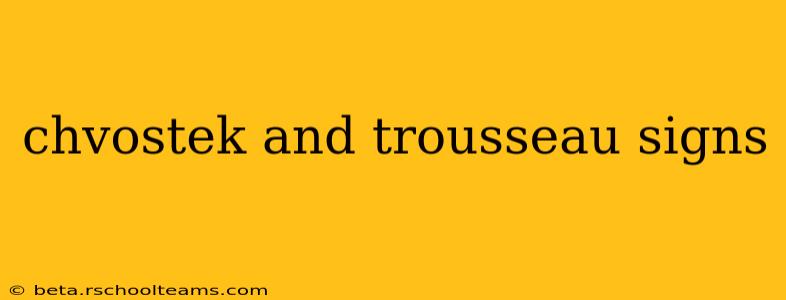Chvostek's sign and Trousseau's sign are two important clinical tests used to evaluate for hypocalcemia, a condition characterized by low levels of calcium in the blood. While both signs suggest hypocalcemia, they assess different neuromuscular responses to the deficiency. Understanding these signs is crucial for healthcare professionals in diagnosing and managing various underlying medical conditions.
What is Chvostek's Sign?
Chvostek's sign is a clinical test that assesses the excitability of the facial nerve. It's performed by tapping the facial nerve in front of the ear, just below the zygomatic arch (cheekbone). A positive Chvostek's sign is indicated by a twitch or contraction of the facial muscles, specifically the orbicularis oculi (muscle around the eye) and the muscles of the mouth. This involuntary muscle spasm is a direct result of the neuromuscular hyperexcitability caused by hypocalcemia.
How to Interpret Chvostek's Sign:
- Positive: A twitch or contraction of the facial muscles upon tapping the facial nerve indicates a positive Chvostek's sign, suggesting possible hypocalcemia. However, a positive sign isn't diagnostic on its own and needs further investigation.
- Negative: The absence of any muscle contraction upon tapping the facial nerve. This doesn't necessarily rule out hypocalcemia, as other tests are needed for confirmation.
- Significance: While a positive result strongly suggests hypocalcemia, it's vital to remember that other conditions can also cause neuromuscular hyperexcitability. Therefore, it is a screening test and not a definitive diagnosis.
What is Trousseau's Sign?
Trousseau's sign is another crucial test for assessing neuromuscular irritability associated with hypocalcemia. This test involves inflating a blood pressure cuff around the arm to a pressure exceeding the systolic blood pressure for 3 minutes. A positive Trousseau's sign is demonstrated by carpopedal spasm—a characteristic hand and finger contraction—during the period of inflation. This spasm occurs due to the increased neuromuscular excitability resulting from low calcium levels. The blood pressure cuff's constriction temporarily reduces blood flow, exacerbating the effects of hypocalcemia.
How to Interpret Trousseau's Sign:
- Positive: The development of carpopedal spasm (contraction of the hand and fingers) during cuff inflation is a positive Trousseau's sign, suggestive of hypocalcemia.
- Negative: Absence of any hand or finger contractions. Again, this doesn't entirely rule out hypocalcemia, and further investigations are necessary for confirmation.
- Significance: Like Chvostek's sign, a positive Trousseau's sign provides strong evidence of hypocalcemia, but it's not a conclusive diagnosis. It warrants further laboratory tests to confirm the calcium levels.
Causes of Hypocalcemia: Understanding the Underlying Conditions
Hypocalcemia, the underlying condition often indicated by these signs, can stem from several sources, including:
- Parathyroid gland dysfunction: The parathyroid glands regulate calcium levels; their malfunction can lead to hypocalcemia.
- Vitamin D deficiency: Vitamin D plays a crucial role in calcium absorption. A deficiency can impair calcium uptake, leading to low blood calcium levels.
- Chronic kidney disease: Impaired kidney function can affect calcium metabolism, contributing to hypocalcemia.
- Pancreatitis: Inflammation of the pancreas can interfere with calcium regulation.
- Certain medications: Some medications can interfere with calcium absorption or metabolism.
The Importance of Further Investigation
Both Chvostek's and Trousseau's signs are valuable clinical indicators. However, they should be considered screening tools, not definitive diagnostic tests. A positive result necessitates further investigations, including blood tests to measure serum calcium levels and other relevant tests to identify the underlying cause of the hypocalcemia. Prompt diagnosis and management of hypocalcemia are crucial to prevent potentially severe complications.
Disclaimer: This information is for educational purposes only and should not be considered medical advice. Always consult a healthcare professional for any health concerns or before making any decisions related to your health or treatment.
